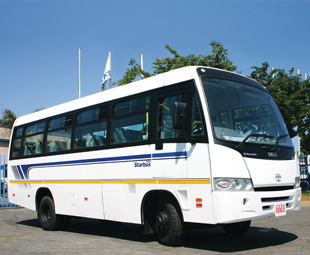LP 713: Indian stunner?

Tata aims to capture a significant proportion of the commuter bus market with its LP 713 Marcopolo bus. But does it make the grade? VIC OLIVER gets behind the wheel…
When South African bus operators are in the market for a new vehicle, Tata is not typically top of mind. Au contraire, the Germans have long dominated the South African market.
However, if this Indian vehicle builder has its way, that will soon change. It’s already changed in the manufacturer’s home country, where Tata has been producing buses for over 50 years. In fact, Tata produces a variety of premium buses and coaches that cater to the entire gamut of utility vehicles and applications, from luxurious inter-city travel options to safe transport choices for school children. It’s fully built buses come in a wide range (from 12 to 67 seaters), chassis options vary from 4 tonne GVM (5 m length) to 17,9 tonne GVM (12 m length). And it sells in such enormous volumes that the company now claims to be the second largest bus manufacturer in the world.
Bearing this in mind, I was keen to get behind the wheel of the Tata LP 713 Marcopolo bus, a 28-seater commuter bus that is fully imported from India. The chassis is built by Tata Motors and then sent to the Marcopolo bus factory in Dharwad, India, where the body is mounted to the chassis before being shipped to South Africa. This modern bus factory is a joint venture between the world-renowned Marcopolo bus building company and Tata Motors.
To ensure that the body meets the strict quality standards set by Marcopolo, each bus that arrives in South Africa is sent to the local Marcopolo factory in Germiston for a pre-delivery check before it is delivered to the customer.
 To test the fuel consumption and the ride quality we took the bus on a 242 km trip to Witbank, returning to the Tata head offices on the N12 highway. The bus used 33,88 litres of fuel on the trip, recording a fuel consumption of 7,14 km/l or 14 l/100km. In my opinion, this is a good figure, especially considering the large frontal area of the bus and the fact that we travelled at the maximum speed allowance of 100 km/h whenever it was safe to do so. It must be noted that the test was done without passengers.
To test the fuel consumption and the ride quality we took the bus on a 242 km trip to Witbank, returning to the Tata head offices on the N12 highway. The bus used 33,88 litres of fuel on the trip, recording a fuel consumption of 7,14 km/l or 14 l/100km. In my opinion, this is a good figure, especially considering the large frontal area of the bus and the fact that we travelled at the maximum speed allowance of 100 km/h whenever it was safe to do so. It must be noted that the test was done without passengers.
On the road the vehicle performed well. The powerful Tata 5,6 litre Euro-2 diesel engine, which produces 95 kW and
416 Nm of torque, enables the bus to maintain a high average speed and allows for safe overtaking of slower moving vehicles.
Coupled to the engine is a driver-friendly synchromesh five-speed manual transmission, with a very smooth gear change. The solid rod gear selection linkage fitted on this model is superior to the cable gear selection linkage, which is often used on competitive models in this class of vehicle.
Being a dedicated bus chassis, the chassis is fitted with longer steel leaf springs than the Tata truck chassis in the same class, resulting in an acceptable ride quality.
With the engine mounted over the front axle the interior noise levels are high and, in my opinion, this is an area that could be improved.
The fitment of a good engine rev counter is another improvement which I believe is necessary to enhance good driving standards and optimise fuel consumption. Without an engine rev counter the driver is not able to use the green band driving technique, which ensures that the bus is driven in the most economical mode.
The vehicle is fitted with a highly effective full air brake system and with automatic slack brake adjustors. Full air brake systems are normally only found on larger vehicles and therefore the Tata LP 713 bus has a clear advantage over most of its competitors in this class of vehicle.
Spring brake boosters are also fitted to the brake system and are used to activate the parking brake. The spring brake boosters will also stop the bus in the unlikely event of a loss of air pressure.
The bus is fitted with a large front windscreen, allowing excellent driver vision. Replacement front windscreens are available locally at a reasonable price.
Due to the large body structure support pillar next to the driver’s compartment and the sliding window frame, the right-hand outside driver’s mirror is not clearly visible. As the mirror is a safety critical item, the mirror fitment and position should be modified.
Tata Motors supports the bus with a standard warranty of one year or 100 000 km. The company also offers an extended warranty of three years or 300 000 km at an additional cost of R5 000. For complete peace of mind I would recommend that any potential buyer purchase the extended warranty.
Parts and service back-up are available from a countrywide network of 34 dedicated Tata dealers situated throughout South Africa, Botswana and Namibia.
The bus is not fitted with an air-conditioner, nor does it offer very much passenger luxury. However, at the present purchase price of R383 850 excluding VAT (which includes the extended warranty), the Tata LP 713 is good value for money if you are looking for a basic 28-seater commuter bus built for tough African operating conditions.
Published by
Focus on Transport
focusmagsa



